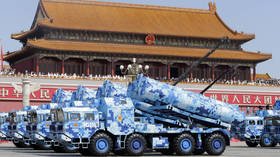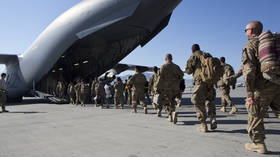US-Russia naval game of chicken off Vladivostok is more dangerous than it seems
The US has resumed and escalated Cold War-era challenges to Russia’s territorial water claims in the Far East. But by sending its warship next to Russian shores, it’s pushing Moscow further into China’s embrace.
On Tuesday, November 24, Vladivostok, the main city of the Russian Far East, was still coping with the aftermath of a cataclysmic ice storm that left tens of thousands of residents without power, heating and running water. Unbeknownst to the city residents, another drama – completely man-made – was unfolding on the same day on the sea less than one hundred kilometers from Vladivostok. Two great powers, the United States and Russia, were engaged in a naval showdown.
On November 24 the USS John S McCain guided missile destroyer entered Russian-claimed waters in Peter the Great Bay in the Sea of Japan (also known as the East Sea) in order to conduct a freedom-of-navigation operation aimed at challenging Russia’s “excessive maritime claims.” The American warship was intercepted by the Russian anti-submarine destroyer Admiral Vinogradov which, according to the Russian defense ministry, threatened the McCain with a ramming maneuver, forcing the US warship to leave Russian waters. “After the warning was issued and the Admiral Vinogradov changed its course, the USS John S McCain destroyer returned to international waters,” the defense ministry said in a statement. The US Navy’s 7th Fleet, though, denies that any such expulsion took place: “The United States will never bow in intimidation or be coerced into accepting illegitimate maritime claims, such as those made by the Russian Federation.”
Also on rt.com If the West keeps sidelining Russia, it could create a giant North Korea and land in big troubleThe legal status of Peter the Great Bay, where the naval encounter took place, is controversial. In 1957 Moscow declared its full sovereign jurisdiction over the bay as the Soviet Union’s internal waters, a claim the US has never recognized. During the Cold War, the US periodically challenged the Soviet claim by sending warships close to the Russian Far East’s shores on “freedom of navigation” missions. The last such operation was held in 1987. After that, for more than three decades, the US government refrained from openly challenging Russia’s ownership of Peter the Great Bay. However, in December 2018 forays into the waters off Vladivostok resumed. Someone in the US government apparently decided that time was ripe to remind Russia about the principle of freedom of the seas. The John S McCain’s uninvited visit to the Russian Far East is the second such incident in two years.
The latest encounter off Vladivostok ended more or less uneventfully, with the US warship briefly crossing into Russian-claimed waters and then leaving. A safe finale, though, was not guaranteed. The Admiral Vinogradov, which escorted the McCain, was in all likelihood not bluffing when issuing the warning that it would ram the US vessel. There is little doubt the commander of the Vinogradov was under instructions to force the perceived intruder out of Russian waters using all available means short of opening fire. Incidentally, the US and Russian naval vessels in this encounter were about the same size, meaning roughly equal chances in case of collision.
The Russian sailors have some experience in ramming attacks against US warships on freedom-of-navigation missions. In the waning days of the Cold War, in February 1988, Soviet warships deliberately bumped USS cruiser Yorktown and the destroyer Caron when they entered Soviet territorial waters in the Black Sea. Tellingly, the Russian media have lately devoted a lot of attention to this long-forgotten episode, presenting it as an act of heroism.
Since the Ukraine crisis of 2014 there has been a remarkable rise in the number of dangerously close encounters between Russian and US military forces at sea, midair and on the ground. In one naval episode, in June 2019, the same Russian destroyer Admiral Vinogradov had an encounter with the USS Chancellorsville in the Philippine Sea, suddenly changing course and forcing the American warship to reverse all engines at full throttle to avoid a collision.
Russia’s willingness to take on US warships may seem illogical, given a vast gap in naval might between Russia and the US. In this particular case, the Russian Pacific Fleet, headquartered in Vladivostok, is no match to the US 7th Fleet based in the Japanese port of Yokosuka. Suffice it to say that the Russian Pacific Fleet has received not a single major new warship since the late 1980s. It is now mostly a force to provide coastal defense to the Russian Far East. Playing the game of chicken with the US military in this and other similar brinkmanship incidents is a way for Russia to offset its material weakness by demonstrating superior resolve. And the closer to the Russian borders such encounters happen, the more this balance of resolve favors Russia. In confronting the McCain in waters near Vladivostok, the balance of resolve certainly was on Russia’s side.
There is another – probably even more important – strategic dimension to the US-Russia game of chicken. For a long time Washington has been pitching to Moscow the theory that China is the main threat to the Russian Far East (a new addition to this narrative is that China has also become a menace to Russia’s Arctic). Ironically, it’s not Chinese but US warships that try to challenge Moscow’s control in waters off Russia’s shores. This is a sure way to further push Russia into China’s embrace. Sino-Russian freedom-of-navigation operations off Alaska, Hawaii or Okinawa may be just a matter of time. Russia’s audacity and China’s expanding navy will be a good match.
Think your friends would be interested? Share this story!
The statements, views and opinions expressed in this column are solely those of the author and do not necessarily represent those of RT.
















